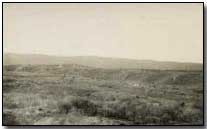Battles - The Battle of Hill 60, 1915
 The Battle of Hill 60,
conducted by Anzac commander
William Birdwood,
was designed to support General
Henry de Beauvoir de Lisle's far larger
attack at Scimitar
Hill on the same day in what comprised the final British attack at
Gallipoli. Both attacks were intended as a last-ditch Allied attempt
to break northwards out of the restricted beachhead at
Anzac Cove
and link up with the Allied force sited at
Suvla Bay.
The Battle of Hill 60,
conducted by Anzac commander
William Birdwood,
was designed to support General
Henry de Beauvoir de Lisle's far larger
attack at Scimitar
Hill on the same day in what comprised the final British attack at
Gallipoli. Both attacks were intended as a last-ditch Allied attempt
to break northwards out of the restricted beachhead at
Anzac Cove
and link up with the Allied force sited at
Suvla Bay.
Hill 60 - named, as was often the case with such features during the war, after its height in metres (although referred to as Kaiajik Aghyl by the Turks) - was the sole prominent feature sited between Anzac Cove and Suvla Bay. Its possession was therefore a stated Allied aim and its capture would provide for safer communications between the two Allied sectors.
Unfortunately Birdwood's available force was much diminished - due to dysentery, exhaustion and battle casualties - and he could only muster some 3,000 troops for deployment under Cox.
As was the case during the earlier attempt to capture the Sari Bair ridge from Anzac Cove on 6 August, reconnaissance proved highly problematic owing to the effectiveness of Turkish sniping. Nevertheless Cox attacked the hill's western slopes across a shallow valley on the evening of 21 August without notable gain, meanwhile suffering heavy casualties from Turkish flank machine gun fire. Renewed attacks the following morning similarly failed.
In spite of his heavy losses Cox determined to renew the attack at 5am on 27 August and, following 36 hours of constant fighting, the Turkish ring of trenches around the hill fell into Allied hands. It was at this stage that the weakness of poor Allied reconnaissance became apparent, when a hitherto unknown Turkish trench line to the east opened fire upon Cox's force.
Anzac commander William Birdwood consequently abandoned the attack the same day. 2,500 Allied casualties had been incurred.
To view maps detailing the progress of the Gallipoli campaign click here; and here; and here; and here.
Photograph courtesy of Photos of the Great War website
"Harry Tate" was the nickname given by British pilots to the R.E.8 aircraft
- Did you know?
